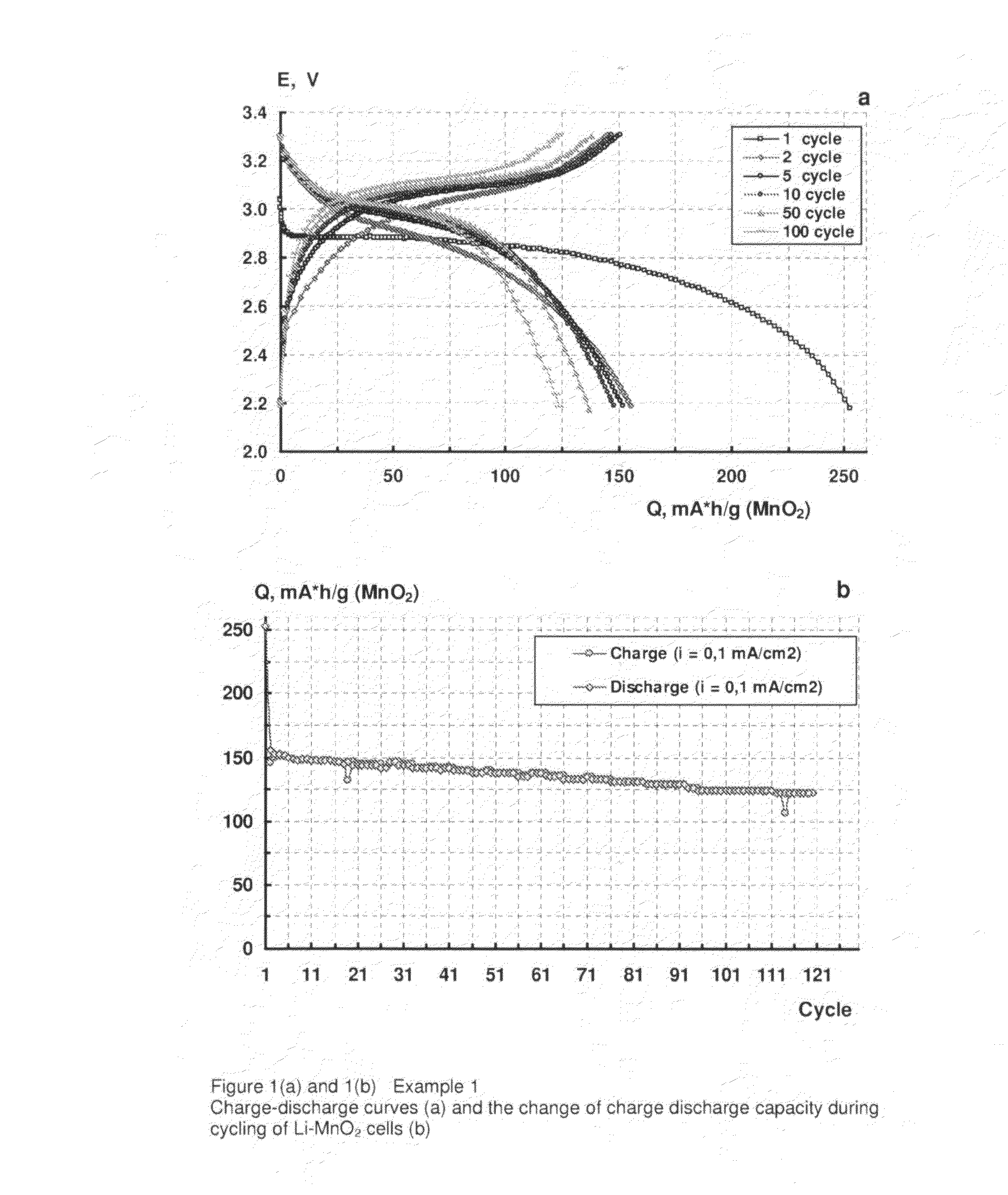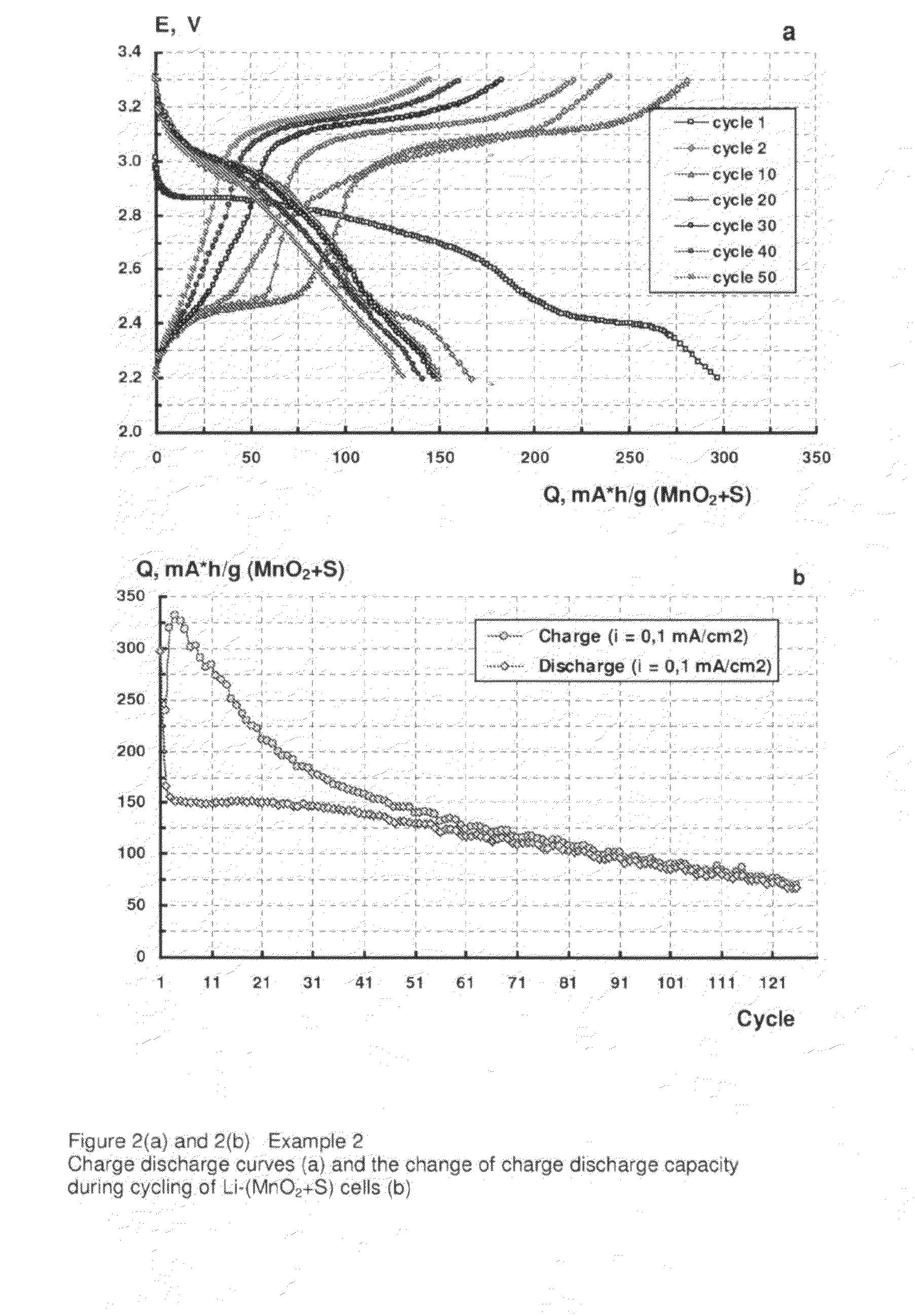Rechargeable battery with negative lithium electrode
a technology of negative lithium electrodes and rechargeable batteries, applied in the field of electrochemical power engineering, can solve the problems of dendrite formation that cannot be completely solved, and achieve the effects of reducing or preventing cathodic deposition of dendrite lithium, and facilitating dendrite lithium dissolution
- Summary
- Abstract
- Description
- Claims
- Application Information
AI Technical Summary
Benefits of technology
Problems solved by technology
Method used
Image
Examples
example 1
[0049]A positive electrode made up of 70% MnO2 (available from Sigma-Aldrich, UK), 10% electro-conductive carbon black (Ketjenblack EC-600JD, available from Akzo Nobel Polymer Chemicals BV, Netherlands) and 20% polyethylene oxide (PEO, 4,000,000 molecular weight, available from Sigma-Aldrich, UK) was prepared according to the following procedure.
[0050]A mixture of dry components was milled in a high speed grinder (Microtron MB550) for 15 to 20 minutes. Acetonitryl was added to the mixture as a solvent for the binder. The resulting suspension was then mixed for 15 to 20 hours in a DLH laboratory stirrer. The solids content of the suspension was 5%. The suspension thus produced was deposited by an automatic film applicator (Elcometer SPRL) to one side of an 18 μm thick aluminium foil with an electro conductive carbon coating (Product No. 60303 available from Rexam Graphics, South Hadley, Mass.) as a current collector.
[0051]The carbon coating was dried in ambient conditions for 20 hour...
example 2
[0056]A positive electrode made up of 60% MnO2 (available from Sigma-Aldrich, UK), 10% electro-conductive carbon black (Ketjenblack EC-600JD, available from Akzo Nobel Polymer Chemicals BV, Netherlands), 20% polyethylene oxide (PEO, 4,000,000 molecular weight, available from Sigma-Aldrich, UK) as a binder and 10% sublimated, 99.5% sulphur (Fisher Scientific, UK) was prepared according to the following procedure.
[0057]A mixture of dry components was milled in a high speed grinder (Microtron MB550) for 15 to 20 minutes. Acetonitryl was then added to the mixture as a solvent for the binder. The resulting suspension was then mixed for 15 to 20 hours in a DLH laboratory stirrer. The solids content of the suspension was 5%. The suspension thus produced was deposited by an automatic film applicator (Elcometer SPRL) to one side of an 18 μm thick aluminium foil with an electroconductive carbon coating (Product No. 60303 available from Rexam Graphics, South Hadley, Mass.) as a current collect...
example 3
[0064]A positive electrode made up of 80% MnO2 (available from Sigma-Aldrich, UK), 9% electro-conductive carbon black (Ketjenblack EC-600JD, available from Akzo Nobel Polymer Chemicals BV, Netherlands), 1% graphite (Printex XE2, Degussa GB FP) and 10% PTFE (Teflon®) was prepared according to the following procedure.
[0065]A mixture of dry components (MnO2, carbon black and graphite) was milled in a high speed grinder (Microtron MB550) for 15 to 20 minutes. A suspension of PTFE in water mixed with isobutyl alcohol was added to the mixture of dry components keeping it thoroughly mixed. The mass obtained was calendared into several homogenous sheets having a thickness of 200 μm, from which a positive electrode of surface area 5 cm2 was produced.
[0066]The positive electrode was dried in ambient conditions for 20 hours.
[0067]The positive electrode was used in a small cell producing electric current with an electrode surface area of about 5 cm2. The electrode was dried in a vacuum at 50° C...
PUM
 Login to View More
Login to View More Abstract
Description
Claims
Application Information
 Login to View More
Login to View More - R&D
- Intellectual Property
- Life Sciences
- Materials
- Tech Scout
- Unparalleled Data Quality
- Higher Quality Content
- 60% Fewer Hallucinations
Browse by: Latest US Patents, China's latest patents, Technical Efficacy Thesaurus, Application Domain, Technology Topic, Popular Technical Reports.
© 2025 PatSnap. All rights reserved.Legal|Privacy policy|Modern Slavery Act Transparency Statement|Sitemap|About US| Contact US: help@patsnap.com



